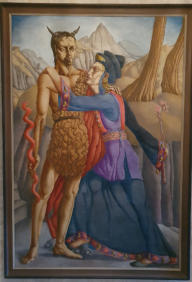



All texts copyright Richard Shillitoe
aaron meeting moses in the desert
1932
Oil on canvas.
76 x 51in. (193 x 130cm.)
Signed and dated lower left.
Provenance
Sotheby’s, studio sale, 24 April 1985, lot 480, ill. b/w, left/right reversed.
Exhibited
London, Whitechapel Art Gallery, 1935, no. 17.
Cheltenham, Municipal Art Gallery, 1936, no. 26.
Colquhoun depicts Aaron wearing the robes of the High Priest. She has
painted the picturesque costume with great accuracy. He has a tunic of
fine linen covered by a robe of woven material. The hem and cuffs of the robe are finished with a row
of tassels, resembling pomegranates, and which alternate with bells of gold. His richly embroidered
waistcoat, or ephod, has an onyx shoulder buckle and is covered by a breast plate bearing twelve
differently coloured gem stones set in gold. The breast plate is held in place by gold chains inserted
through gold rings. On his head Aaron has a linen mitre, fronted by a plate of pure gold. The
individual garments that make up the robes contain complex symbolic meanings within their fabrics
and colours.
In contrast to the sophisticated, clean shaven, rather androgynous Aaron, Moses is much less richly
attired, being bare-footed and clothed only in a sheep skin. The ram’s horns growing from his head
add to his primitive appearance. They originate in a mistranslation of the original Hebrew text, which
confuses the word for ‘rays of light’ with ‘horns’. The mistake has become the basis of mystical ideas
which attempt to synthesise Christianity with the worship of the horned Egyptian god Amun.
Both Moses and Aaron carry a rod which symbolises their authority. The shape of Moses’ rod, in the
form of a serpent, refers to the time when he met Pharaoh. He cast his rod upon the ground,
whereupon it turned into a snake, resuming its normal form when he picked it up.
The leader of each of the tribes of Israel carried a rod which was placed in the tabernacle overnight.
One morning, Aaron’s had sprouted, producing blossoms and bearing almonds. This was taken to
indicate Aaron’s pre-eminence and he subsequently became the High Priest of all the tribes.
At just over six feet tall, this canvas has the same dimensions as Death of the Virgin (1931). These are
the largest of Colquhoun’s works painted in her early, Slade influenced, naturalistic style.
Ethel Walker commented on the effeminate appearance of Aaron and his rather ambiguous gesture,
referring to the painting as ‘Aaron kissing Moses’. In a similar vein, in ignorance of the subject matter,
Colquhoun’s framer later referred to the work as ‘Horned Gentleman with Bejewelled Lady’.


















